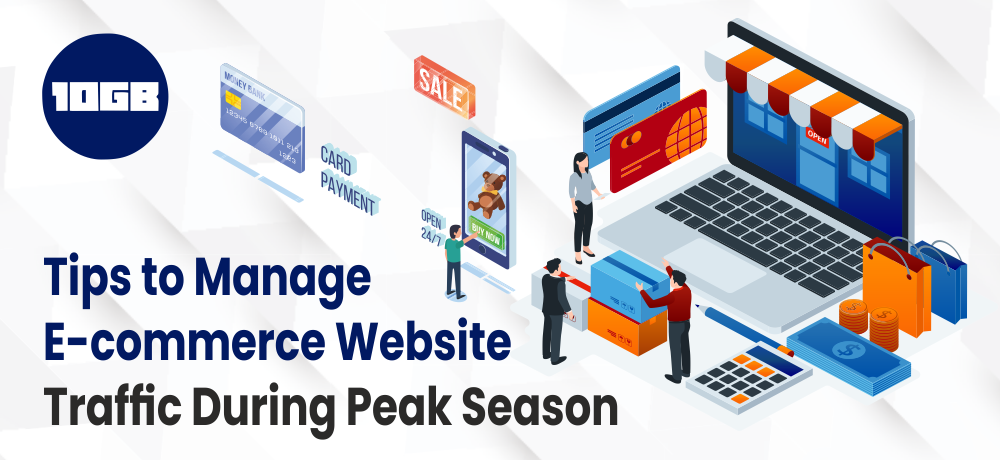Festivals across the globe have always been the boosters for an increase in sales, for both offline and online stores. With the introduction of an e-commerce website or store, the shopping sector has seen massive growth as more and more people choose online shopping. The reason for this due to the comfort of buying services or products, a wide range of choices, seamless online payments, and most significantly, the appealing discounts provided by the platforms.
Being an e-commerce website owner, your main aim should be to leverage the surge in traffic during peak season. However, say it is simpler than actually doing it. You need to plan well in advance to manage or handle such traffic surges on an e-commerce website. During such peak hours, you wouldn’t want your website to experience frequent downtime.
The initial step for optimizing any website depends on the kind of hosting you are using. There are several hosting options available in the market. However, hosting types such as Managed VPS or Cloud Hosting can be a powerful and affordable hosting solution for e-commerce websites. The scalability and advanced security linked with Cloud Hosting can help you tackle an unexpected surge in traffic easily.
Steps to Manage E-commerce Website Traffic During Peak Season:
Make sure your website doesn’t experience downtime
Downtime could incur your business a massive loss during the holiday season. Even though you have done everything right, like stocking up, advertisements, etc, the whole objective would fail if your website is down and inaccessible. Conventional hosting like shared hosting may fail during sudden traffic spurge. There is a high chance that your website may experience downtime. But, Cloud Hosting is the best platform to host your e-commerce website.
Communicate with your hosting provider well in advance, to know about the limitations of your hosting type and get prepared in advance. There are several tools that you can install to monitor your website’s uptime score. Surveys recommend that the top e-commerce websites had an uptime score of 99.9% while seasonal traffic surge.
Ensure high page speed
An optimal website loading speed should be under 2 seconds anything more than that can drive away over 40% of your potential clients. Website site loading speed is not only necessary for SEO rankings but also is an important factor to improve user experience. The bottom line is speed sells. You can use tools like Google’s PageSpeed Insights, which not only measure various parameters associated with page speed but also provides you suggestions for improvement. A mere 2-second acceleration in page speed can enhance your conversion rate by a tremendous 66%.
Suggested for Further Reading:
- Tips to Improve Landing Page Performance of WordPress Site
- Does Server Location Impact Website SEO? What You Need to Know
Boost security to give confidence to the client:
Give assurance to your clients that your website is secure to overcome the incoming onslaught of traffic. There are several methods to safeguard your site. All the admin should use 2FA or 2-Step authentication process. The server should have a firewall and antivirus installed. Also, make sure you have an SSL certificate installed. This is a must-have feature for e-commerce websites as they save precious information of the users like credit card details and private information.
Make use of the CDN:
A CDN or Content Delivery Network works by making static content of the website and storing them on servers throughout the world. Whenever the website is accessed by the user, the information is loaded from the most proximal location, thus getting the information at a lightning-fast speed. Additionally, this avoids overburdening the server, eradicating repeated HTTP requests to it. CDN also plays as the first line of defense against cyberattacks and DDoS as the attackers will not able to search for your original IP address. There are several CDNs available in the market, such as Cloudflare, Key CDN, etc.
Optimize the mobile version of the website
As more and more people are turning to their mobile phones for the internet. Simply having a mobile-optimized website may not be enough for an e-commerce website. In fact, making an app for various platforms would be an excellent approach to manage the seasonal traffic surge. For seamless purchase, a user may not have to do extreme zooming and scrolling. There are several tools that can analyze and provide reports on whether a specific website is mobile-friendly or not. Tools such as Google’s Search Console gives actionable insights for your e-commerce website.
Improve customer support beforehand
The surge in traffic could lead to increased work in the backend of your business. There would be several queries from your customers. Having an FAQ page on the website can reduce many of the user’s queries. If the website can solve their queries or doubts, it would drive to a better conversion rate. Additionally, live chats and quick email resolution for their queries can go a long way in dealing with an increased number of clients.
Simplify the checkout process
Nearly 70% of abandoned cart rates are caused due to several checkout processes based issues such as complicated checkout, website crash, not enough payment methods, unsatisfactory shipping policy, etc. Additionally, creating too many pages increases your website size, causing it to load slower. It is a good approach to streamline the process to a few steps. Having a smart quick buy button just next to the product can save the client’s time as well as not overburden your server.
Conclusion
There are several challenges involved in capitalizing on the seasonal surge in traffic for your e-commerce website. Hence, it may not be a good idea to wait for the last minute to do significant changes.
